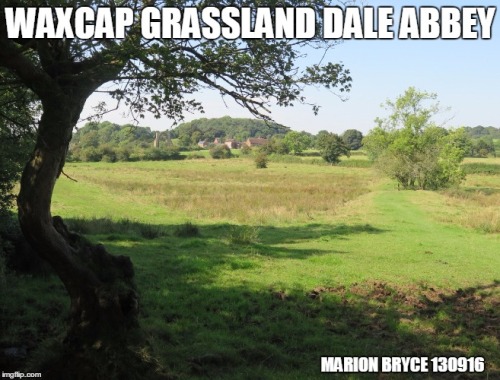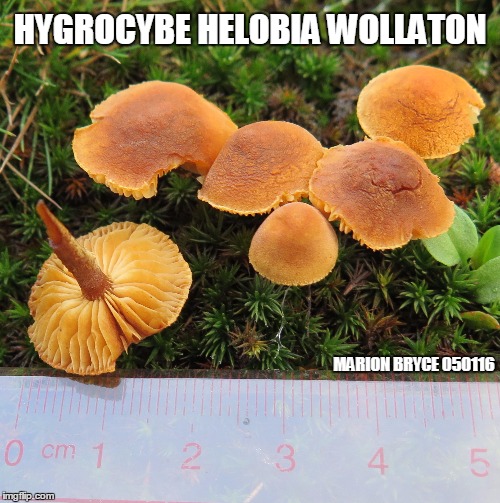If you see bright red, orange and yellow mushrooms in unimproved turf, you are probably looking at waxcaps (Hygrocybes), these are the CHEG species best known and easiest to identify which are indicators of the rich waxcap grasslands threatened throughout the UK and Europe.

Waxcap-grassland fungi are characteristic of unimproved, nutrient poor grasslands, with moss rich highly grazed swards. They can be split into five groups; dung fungi, litter decomposers, terricolous species, mycorrhizal species and CHEG species. It seems likely that there is a mutual relationship between CHEG species and mosses. Many grassland species are threatened and over 250 are included on European Red Data Lists.
Higher waxcap diversity can occur in semi-improved and botanically mundane grasslands so more meaningful surveys count species of five main types of fungi: Clavariaceae (Fairy Clubs), Hygrocybe (Waxcaps), Entolomacea (Pink gills) and Geoglossaceae (Earth tongues). These are known as the CHEG fungi using the first letter of their name. Now crazed caps -Dermoloma are included, so sites are evaluated using the CHEGD score rather than a score for wax caps alone.

Three waxcap-grassland species are included on the UK Biodiversity Action Plan:
- pink waxcap Hygrocybe calyptriformis
- date waxcap Hygrocybe spadicea
- olive earthtongue Microglossum olivaceum
Three grassland taxa, all of which occur in England have now been proposed for inclusion in Appendix I of the Bern Convention on the Conservation of European Wildlife and Natural Habitats. They are Hygrocybe calyptriformis, Entoloma bloxamii and
Geoglossum atropurpureum.The pink waxcap Hygrocybe calyptriformis appears mainly in neutral grasslands. Also known as the ballerina it has been the subject of much conservation attention as a flagship species. The UK holds nearly 50% of its known European sites.
Site assessment should be based on cumulative site visits as different fungi fruit at different times of the year. The CHEGD value is the total of CHEGD species found although the more easily recognised waxcaps are more often scored on site visits. The score is also used to assess the site in a local context, when a lower CHEGD score may be significant.
| Conservation value | Total from all visits |
| No particular value | 1-3 |
| Local | 4-8 |
| Regional | 9-16 |
| National | 17-21 |
| International importance | 22 |
Table I to show conservation value of grassland based on waxcaps
| Type | |
| Clavariaceae | 7 |
| Hygrocybe | 17 |
| Entoloma | 15 |
| Geoglossaceae | 4 |
| Dermaloma | Not known |
| Total | 43 |
Table II to show CHEGD criteria for grassland of national importance
Locally there are waxcap grasslands recognised to be of national importance
| The Top Sites in England | C | H | E | G | D | BAP species |
| International importance | ||||||
| Longshaw Estate | 8 | 33 | 24 | 4 | Not known | Entoloma bloxamii, Hygrocybe calyptriformis |
| National importance | ||||||
| Bradgate Park | 4 | 19 | 3 | 0 | Not known | |
| Chatsworth Estate | 5 | 18 | 7 | 0 | Not known | Hygrocybe calyptriformis |
Most of the data has been supplied by the Royal Mycological Society. It is interesting to look at some sites even closer to home.
| Scientific name | Stoney Clouds* | Pioneer Meadows | Dale Abbey | Wollaton Hall Lawn | Kedleston* | Shipley* | Nottm Univ Park | |
| Waxcap | Hygrocybe helobia | x | ||||||
| Bitter | H.mucronella | x | ||||||
| Butter | H. ceracea | x | ||||||
| Cedarwood | H.russocoriacea | x | ||||||
| Conical | H. conica | x | x | x | x | |||
| Crimson | H. punicea | x | ||||||
| Date | H. spadicea | x | ||||||
| Golden | H. chlorophana | x | x | x | x | |||
| Heath | H laeta | x | x | |||||
| Honey | H. reidii | x | ||||||
| Meadow | H. pratensis | x | x | x | x | |||
| Parrot | H. psittacina | x | x | x | x | x | ||
| Persistent | H. peristens or autoconica | x | x | |||||
| Pink | H. calyptriformis | x | ||||||
| Scarlet | H. coccinea | x | x | x | x | |||
| Slimy | H. irrigata | x | x | |||||
| Snowy | H. virginea | x | x | x | x | x | x | |
| Spangle waxcap | H. insipida | x | x | |||||
| Vermilion waxcap | H miniata | x | ||||||
| Clavariaceae | ||||||||
| Apricot club | Clavulinopsis luteoalba | x | ||||||
| Caterpillar club | Cordyceps militaris | x | x | |||||
| Golden spindle | Clavulinopsis fusiformis | x | ||||||
| Meadow coral | Clavulinopsis corniculata | x | ||||||
| Yellow club | Clavulinopsis helvola | x | x | x | x | x | ||
| Grey Coral | Clavulinopsis cinerea | x | x | |||||
| Smokey spindles | Clavaria fumosa | |||||||
| Entoloma | Entoloma sericeum | x | x | |||||
| Entoloma chalybeata | x | |||||||
| Dermaloma | ||||||||
| Crazed dome cap | Dermaloma cuneifolium | x | ||||||
| CHEG Score | 8;3;1;0;0 | 6;1;0;0;0 | 11;4;3;0;1 | 4;2;0;0;0 | 7;0;0;0;0 | 1;1;0;0;0 | 7;2;0;0;0 |
*Includes data from Beverley Rhodes
Table III to show CHEGD scores

Important waxcap-grasslands require a long time to develop their characteristic fungi. A minimum requirement could be 20-30 years but hundreds of years has been suggested for the finest sites. Some idea of timescales has been established from observation of the establishment of waxcaps in sites previously farmed intensively. Three or fewer species became established after 20-35 years Certain species establish or re-establish more rapidly than others, snowy waxcap (H. virginea) and blackening waxcap (H. conica)appear to be tolerant of fertilised sites and may reappear after about 10 years whilst more sensitive species like splendid waxcap (H. splendidissima) can require more than 30 years to appear. If Crimson waxcap (H. punicea) is found it can almost be presumed that 8 other waxcap species are present. Careful and concerned management is the key as these sites can very quickly lose their wonderful rainbow fungal flora. Based on the above criteria Pioneer Meadows, Stoney Clouds, Woodpecker Meadow and Abbey Field at Dale Abbey would be classified as waxcap grasslands of local and/or of regional importance.
Marion Bryce 2 November 2016
Ref English Nature Report No 555 Waxcap-grasslands -an assessment of English sites Shelley Evans 2003
